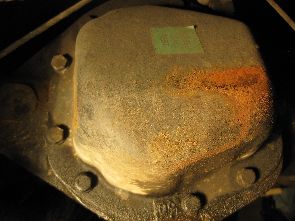312
Not all suspension modifications
on an RV8 are a good idea
Angus Munro bought an RV8 that was advertised with various suspension
modifications supplied by a reputable company. He found the
handling of the car was alarming. Here he describes what he
found and how he cured the problems. (Nov
09)
The release from the traffic of Norwich to the open A146 is
a joy. The morning is dry and bright and the long gentle left
curve simply beckons the RV8. The big V8 laughs lazily at my
puny attempt at acceleration. Ahead the traffic moves into my
lane, the outside lane. No need to brake, just lift off quickly.
"Expletive!" - the right front wing dips and the right
front wheel bites, tucks in and I swerve across towards the
nearest lane.
Snap oversteer when lifting off the throttle mid-corner. This
scenario is also known as: lift off oversteer, snap-oversteer,
trailing-throttle oversteer, throttle-off oversteer and lift-throttle
oversteer. Take your pick, it's frightening. I like to think
that I did the right thing. I think I had steered in the direction
I had originally intended with a firm foot on the accelerator
again. In truth, I was not sure but of two things I am very
certain - had the road been wet I would have spun with a horrible
result and secondly, this car has to be sorted out! Here Angus
Munro explains what he found and decided to do.
When I was looking for an RV8 I sought the advice of owners,
all of whom confirmed that the ride and handling of the car
was good but inevitably wasn't comparable to that of a modern
car with respect to the suspension. Eventually I found a car
that was advertised with various suspension modifications supplied
by a reputable company. I test drove the car at modest speeds
on local roads near the owner's house and agreed to purchase
the RV8. During the drive home at motorway speeds the nature
of this particular beast became apparent. It was terrifying.
A drive the following day through the bumpy lanes of north Norfolk
was equally worrying with the rear axle crashing about noisily.
What had I done? Surely an MG RV8 was not this bad?
After I had raised many questions by email and on the bulletin
board I finally came to the conclusion that the castor angle
on my RV8 was wrong. The MGB was designed with 7 degrees of
positive castor and the aluminium castor reduction wedges that
are available as simple kit simply rotate the front crossmember
to reduce the castor angle by 3 degrees. The effect is to lighten
the steering effort required. While this may work on the MGB,
the crossmember designed by Rover for the RV8 has only 4 degrees
of positive castor - well, 3 degrees 48 mins plus or minus 54
mins if you want to be picky. By having my RV8 fitted earlier
with these wedges they had removed 3

Panhard
rod polished from friction contact with the diff casing. (Photo:
Angus Munro)
|

Differential
with the impact marks from the Panhard rod: a long mark to the
right and a spot mark which was shiny two months earlier. (Photo:
Angus Munro)
degrees
of castor. So with less than one degree, and possibly zero degrees
of positive castor angle, I was driving a 3.9 litre supermarket
trolley. I had the wedges removed, as did several other RV8
enthusiasts with whom I was in contact, and the result was a
dramatic improvement. But my car was still awful.
At the time of my purchase the previous owner offered me two
rusty tubes of steel, each with a bush at each end, saying "these
are no longer required because the Panhard rod now does the
job". I nearly said I didn't want them but then thought,
"hey they might be something I should have . . ."
Later I discovered they were in fact torque control arms and
they were fitted to the RV8 as original equipment! For quite
a while my chums suggested that I should refit those arms to
my RV8, I resisted because the Panhard rod was doing their job
- well wasn't it?
I wanted some
clarification on this matter so I telephoned the firm which
had supplied the modified suspension equipment that had been
fitted to my RV8 for the previous owner and spoke at length
to one of their specialists. He confirmed, quite clearly, that
the torque control arms were redundant and no longer needed
to be fitted to my RV8. My chums insisted however that was not
right and that they should be put back on the car. So as it
was only four bolts after all I eventually gave in and refitted
them. The car was, as they say, "transformed" and
I had to submit to a lot of "I told you so" comments
- even to this day.
However, that is not the end of the story. With peace and quiet
from the now restrained rear axle, a "donk" became
audible and the car also "chuntered" around the area
of the rear axle at low speeds. An unexpected revelation occurred
a few weeks ago when I went to a local garage for an estimate
to have the RV8 professionally cleaned and Waxoyled underneath.
"Have you seen this?" inquired my mechanic pointing
out a bright and shiny spot on the rear differential case. "And
this?" pointing out a bright and shiny flat on the inside
of the Panhard rod. Clearly the Panhard rod was in contact with
the differential casing. So as there is no position adjustment
possible, I got my eagle eyed mechanic to remove the Panhard
rod.
At this point I will confess that I had secretly hoped that
the rear axle might be about to fail as then I would then have
had the opportunity to go for the wonderful Hoyle IRS upgrade
that I have long thought about. But the story has a happy ending
for my bank balance as I am now left with a car that is a delight
to drive. No "donk", no "chuntering" and
in fact an RV8 that is as it had left the factory with none
of the strange and very unwelcome characteristics I had inherited
when I bought the car fitted with those two suspension modifications
and with the torque control arms removed.
See
a full copy of RV8NOTE312 |



